 |
 |
 |
 |
 |
 |
| |
 |
|
 |
 |
 |
  |
  |
 |
 |
 |
 |
| MUSEI COME SUPERMERCATI, GRANDI MAGAZZINI COME MUSEI
|
|
3 aprile 2011
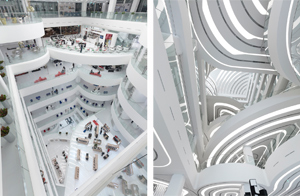 Ben van Berkel / Galleria Centercity a Cheonan di UNStudio - "Se i musei si stanno trasformando in supermercati, perché i grandi magazzini non si trasformano in musei?" Ben van Berkel / Galleria Centercity a Cheonan di UNStudio - "Se i musei si stanno trasformando in supermercati, perché i grandi magazzini non si trasformano in musei?"
"La Galleria Cheonan risponde alle attuali tendenze degli spazi commerciali in Asia, dove i grandi magazzini svolgono anche una funzione di luoghi di incontro e fungono da catalizzatori sociali. Di conseguenza, la qualità degli spazi pubblici all'interno dell'edificio è stata trattata come un aspetto integrante del design."
Ben van Berkel
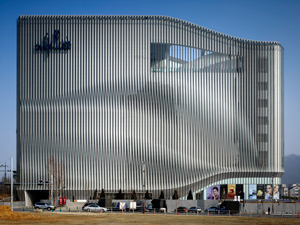 Eye Shopping - Ri-appropriazione degli spazi pubblici all'interno di un centro commerciale. Eye Shopping - Ri-appropriazione degli spazi pubblici all'interno di un centro commerciale.
Il centro commerciale Galleria Centercity, di UNStudio, nella città coreana di Cheonan si riappropria di spazi sociali e culturali all'interno di un grande centro commerciale privato. Invece di essere il risultato degli standard prescritti, il progetto di Galleria Centercity si basa sullo studio delle più recenti tendenze comportamentali all'interno dei grandi spazi commerciali. In particolare nel Sud-est asiatico i centri commerciali sono diventati spazi che svolgono funzioni sociali: sono luoghi di ritrovo dove le persone si incontrano per mangiare, bere, e dove gli acquisti sono degli intermezzi. Il grande magazzino non è più soltanto uno spazio commerciale ed oggi offre all'architetto l'opportunità di sviluppare ed ampliare l'esperienza sociale del visitatore. Se oggi stiamo vedendo i musei come dei supermercati possiamo iniziare a vedere i centri commerciali come dei musei.
L'essenza del progetto è quindi costituita da un'interpretazione estesa dell'utilità, dove vengono prese in considerazione sia efficienza che redditività. Quindi, con un programma più variegato, il progetto di UNStudio mira a fornire al visitatore un'esperienza stimolante. Quest'aspetto si traduce in qualcosa di molto difficile da risolvere nell'aspetto esteriore. Le facciate a doppio strato sono articolate in un rivestimento che compone un trompe l’oeil di montanti verticali. Le linee verticali della facciata rendono illeggibile la scala dell'edificio: contiene tre piani o quindici? All'interno, questo giocare con la scala e le dimensioni, continua su una strada altrettanto radicale. Entrando il centro commerciale si mostra come uno spazio stratificato e multiforme che stimola alla sua esplorazione ed invita a muoversi dentro l'edificio. La Galleria Cheonan incorpora una serie di spazi culturali e pubblici, tra i quali una galleria d'arte, un centro culturale e una sala vip. Nel seminterrato uno spazio alimentare ed un supermercato specializzato costituiscono altre destinazioni all'interno dell'edificio che sono, al tempo stesso, distinte ed integrate nel piano generale del progetto.
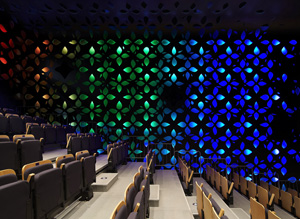 Cheonan –New city development as platform for innovation Cheonan –New city development as platform for innovation
Situated some 80km south of Seoul, Cheonan is well connected to the capital by railway and road, with a new high speed rail link having recently been completed. The area around the new high speed terminal is under development and - prominently visible from the main road - the Galleria Centercity marks the entrance to this new development area.
"The most interesting thing to me about the effect of the Galleria Cheonan is that, because of the organisation of the atrium and the moiré treatment of the facade, Illusions are created which result in the seeming alteration of scales and the creation of double images. No image is permanent in this building."
Ben van Berkel
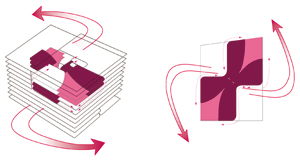 Dynamic Flow and optical illusion on a grand scale Dynamic Flow and optical illusion on a grand scale
The main architectural theme for the Galleria Cheonan is that of dynamic flow. This is found both inside and outside. The architecture of the 66,000 m² building responds to its central position by presenting a deliberately changeable aspect all-around. Moiré effects, special lighting and animations ensure that the outside changes appearance constantly.
The double layered facade encloses the building, with a number of strategic openings incorporated into the inner facade layer. These openings provide daylight to the interior. At the same time, the lamellas of the outer façade prevent direct sunlight from entering the building, ensuring a cooler environment, while the use of white finishes throughout the interior minimises the need for artificial lighting.
The interior derives its character from the accumulation of rounded plateaus on long columns. The repetition of curves, enhanced by coiled strip lighting in the ceilings of the platforms, gives the interior its distinctive character. Four stacked programme clusters, each encompassing three storeys and containing public plateaus, are linked to the central void. This organisation propels a fluent upstream flow of people through the building, from the ground floor atrium to the roof terrace. As the plateaus are positioned in a rotational manner in space, they enable the central space to encompass way finding, vertical circulation, orientation and act as main attractor of the department store. The spatial and visual connections within the space are designed to generate a lively and stimulating environment, in which the user is central.
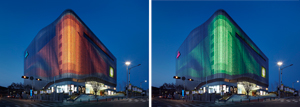 Media facade - The largest illuminated surface of its kind in the world Media facade - The largest illuminated surface of its kind in the world
The strategy for the building enclosure consists of creating an optical illusion. During the day the building has a monochrome reflective appearance, whilst at night soft colours are used to generate waves of coloured light across the large scale illuminated surface. The lighting design was developed in parallel with the architecture and capitalises on the double layered facade structure. Computer generated animations specially designed by UNStudio are incorporated into the lighting design and refer to themes related to the department store, such as fashion, events, art and public life.
Place branding – not name branding
Rather than creating a platform for a multiple billboard effect made up of individual brand identities, the thematic animated content of the fully integrated media façade facilitates a more holistic and site-oriented urban approach to branding.
Ricerche dal database di Architectour.net
CreditsTesti e immagini gentilmente concessi da UNStudioFoto di Christian Richters, Kim Yong-kwan Traduzione in italiano a cura di Architectour.net
|
|
 |
  |
 |
|
|